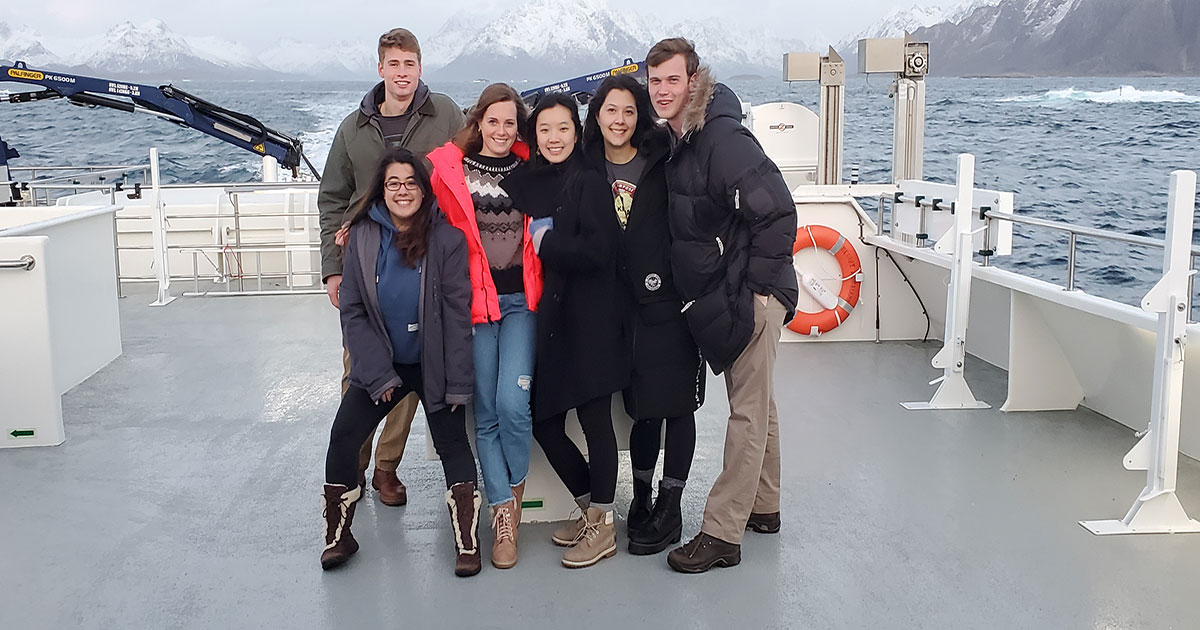Reflecting on a Trip to the Top of the World

Editor’s Note: This story originally was scheduled to run in mid-March, just as the pandemic was starting to disrupt so much of our day-to-day lives. We have decided to revisit it now, because it illustrates so much of the curiosity and spirit that is a hallmark of our students and community.
At the top of the world, the hard choices that humanity must make about its future feel very immediate and real.
Xueer Ning ’20 was one of half a dozen students from Babson College who traveled in January to Bodø, Norway, a town located above the Arctic Circle. They came as part of a course examining climate, policy, and economics in the Arctic.
In this remote place, Ning was struck by the conundrum that Arctic communities face. On the one hand, this is a region particularly vulnerable to climate change, and the burning of fossil fuels poses a serious long-term threat to the way of life there.
But at the same time, fossil fuels are extremely valuable, and many deposits of them are located in the Arctic. “Investing in petroleum extraction can create jobs and reduce reliance on energy imports,” Ning says. “It can provide Arctic communities, many of which are comprised of vulnerable indigenous populations, with more stable forms of employment.”
This choice, between present possibilities and future risks, is something the Babson students examined in their time in Norway, which proved a fitting backdrop for such weighty discussions. “The last undiscovered and underutilized area of the world is the polar ice caps, and they are going away. That opens up an undiscovered country,” says Michael Goldstein, a professor of finance at Babson who designed and led the new class, which was funded in part by a grant he received from the National Science Foundation. “I think it was important to get up there.”
Here Comes the Sun
The Arctic class, entitled Arctic Economics: Climate and Policy, involved a mix of coursework, research, and excursions. For a little over two weeks, students studied at Nord University in Bodø and were joined in the course with students and faculty from Nord and Brown University.
With a population of roughly 50,000 people, Bodø is far removed from Babson Park. Traveling to the town had its challenges. The biggest was probably the lack of sun. When students arrived, the town was receiving only two hours of daylight.
“You can’t get across what it’s like to live in a place with two hours of sunlight until you’re there,” says Goldstein, the Donald P. Babson Chair in Applied Investments, who has long had an interest in Arctic economics and previously brought Babson students to Canada’s Northwest Territories to study ice roads used by long-haul truck drivers.
On the Norway trip, students were encouraged to bring vitamin D supplements, says Margaret Barr-Forget ’20. “It was very confusing when you would wake up for a 9 a.m. class and it would be pitch black out, and then you would get out of class and it would be pitch black out again,” she says. “It often felt like it was time to go to bed right after class.”
The students also gained an appreciation for the harshness of the region. Before one of their excursions, a six-hour ferry ride north to the fishing town of Svolvær, the students visited a search and rescue center. The center’s job is to rescue people in trouble in the cold Arctic waters.
“It was both fascinating and terrifying,” says Brooke Majewski ’20 of the center. “This was my first exposure to the reality of how many ships and lives can be lost at sea. The ocean is a dangerous place. In the Arctic, these dangers are heightened.”
Different Perspectives
Despite being in the Arctic, though, students found the temperature in Bodø to be comparable to that in Wellesley, thanks to the Gulf Stream. Sitting on the sea and surrounded by mountains, the area also was stunning. “It was such a beautiful change of scenery,” says Barr-Forget. “The air up there seemed very clear and fresh.”
“As a student who concentrates on finance, I was surprised that professor Goldstein is able to use his knowledge of derivatives and other financial instruments to forecast the potential of climate change in the future.”
Xueer Ning ’20
In and out of class, the Babson students enjoyed learning and interacting with visiting speakers and the students and faculty from Brown and Nord. That meant hearing from different disciplines and perspectives.
Ning was particularly interested in how Goldstein, as a professor not of environmental studies but of finance, could have such insights into Arctic issues. “As a student who concentrates on finance,” she says, “I was surprised that professor Goldstein is able to use his knowledge of derivatives and other financial instruments to forecast the potential of climate change in the future.”





